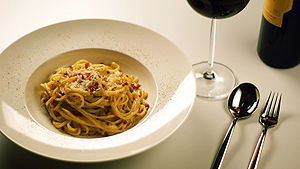Carbonara

Pasta alla carbonara (usually spaghetti, but occasionally linguine or bucatini) is an Italian pasta dish based on eggs, parmigiano, pancetta or guanciale, and black pepper. It is a relatively recently invented dish.[1]
Recipes vary. All agree that cheese (parmesan, pecorino, or a combination), egg yolks (or whole eggs), cured fatty pork (guanciale usually preferred to pancetta) and black pepper are basic. The pork is fried in fat (olive oil or lard); a mixture of eggs, cheese, and butter or olive oil is combined with the hot pasta, cooking the eggs; the pork is then added to the pasta.[2][3][4] Guanciale is the most usual meat, but pancetta is also used.[5][6] Cream is not used in Italian recipes, but is used in the United States,[7][8] and England.[9]
Some American recipes add salt and/or garlic to taste; with peas added for color.[8] Yet another American version includes mushrooms. Most of these preparations have more sauce than the Italian versions, and have more in common with a cream sauce such as that used for Fettuccine Alfredo.
In all versions of the recipe, the eggs are added to the sauce raw, and cook with the heat of the pasta itself.
Origin and history
Like most recipes, the origins of the dish are obscure, and there are many legends about it. As the name is derived from the Italian word for charcoal, some believe that the dish was first made as a hearty meal for Italian charcoal workers. Others say that it was originally made over charcoal grills. Still others suggest that it is so named because the specks of bacon and pepper in the pasta look like bits of charcoal. It has even been suggested that it was created by the Carbonari ("charcoalmen"), an Italian secret society.
The dish was obscure before the Second World War, and it is not present in Ada Boni's classic book La Cucina Romana, which was published in 1927. It is thought to have originated in the hills outside Rome, not in the city itself. Its popularity began after the Second World War, when many Italians were eating eggs and bacon supplied by troops from the United States. It also became popular among American troops stationed in Italy; upon their return home, they popularized spaghetti alla carbonara in North America.
Notes
- ^ Massimo Alberini and Giorgio Mistretta, Guida all'Italia gastronomica, Touring Club Italiano, 1984, p. 286
- ^ Alberini, op.cit.
- ^ Gossetti Della Salda, Anna. Le ricette regionali italiane. Solares, Milan. 1965.
- ^ Accademia Italiana della Cucina, Ricettario nazionale delle cucine regionali italiane
- ^ Luigi Carnacina, Luigi Veronelli, La cucina rustica regionale (2. Italia Centrale), Rizzoli, 1977 republication of La Buona Vera Cucina Italiana, 1966.
- ^ Vincenzo Buonassisi, Il Nuovo Codice della Pasta, Rizzoli, 1985.
- ^ Herbst, Sharon Tyler (2007). The New Food Lover's Companion, Fourth Edition. Educational Series. Barron's. ISBN 0-7641-3577-5.
{{cite book}}: Unknown parameter|coauthors=ignored (|author=suggested) (help) - ^ a b Labensky, Sarah R (2003). On Cooking, Third Edition: Techniques from expert chefs. Pearson Education, Inc. ISBN 0-1304-5241-6.
{{cite book}}: Unknown parameter|coauthors=ignored (|author=suggested) (help) - ^ Wright, Jeni (2006, 2007). Italy's 500 Best-Ever Recipes. London: Hermes House, Anness Publishing. ISBN 0-681-46033-4.
{{cite book}}: Check date values in:|year=(help)CS1 maint: year (link)
